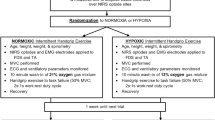Abstract
The quantitative analysis of haemoglobin oxygenation of contracting human muscle during weight-lifting exercise was studied noninvasively and directly using near-infrared spectroscopy. This method was developed as a three-wavelength method which confirmed the volume changes in oxygenated haemoglobin (oxy-Hb), deoxygenated haemoglobin (deoxy-Hb) and blood volume (total-Hb; Oxy-Hb + deoxy-Hb). Nine healthy adult men with various levels of training experience took part in the study. Ten repetition maximum (10 RM) one-arm curl exercise was performed by all the subjects. Results showed that at the beginning of the 10-RM exercise, rapid increases of deoxy-Hb and decreases of oxy-Hb were observed. In addition, total-Hb gradually increased during exercise. These results corresponded to the condition of arm blood flow experimentally restricted using a tourniquet in contact with the shoulder joint, and they showed the restriction of venous blood flow and an anoxic state occurring in the dynamically contracted muscle. In three sets of lifting exercise with short rest periods, these tendencies were accelerated in each set, while total-Hb volume did not return to the resting state after the third set for more than 90 s. These results would suggest that a training regimen emphasizing a moderately high load and a high number of repetitions, and a serial set with short rest periods such as usually performed by bodybuilders, caused a relatively long-term anoxic state in the muscle.
Similar content being viewed by others
References
Anrep GV, Saalfeld EV (1935) The blood flow through the skeletal muscle in relation to its contraction. J Physiol 85:375–399
Barendsen GJ, Van Den Berg J (1984) Venous capacity, venous refill time and the effectiveness of the calf muscle pump in normal subjects. Angiology 35:163–172
Corcondilas A, Koroxenidis GT, Shepherd JT (1964) Effect of a brief contraction of forearm muscles on forearm blood flow. J Appl Physiol 19:142–146
Eiken O, Sundberg CJ, Esbjornsson M, Nygren A, Kaijser L (1991) Effects of ischaemic training on force development and fibre-type composition in human skeletal muscle. Clin Physiol 11:41–49
Gollnick PD, Armstrong RB, Saubert CW IV, Piehl K, Saltin B (1972) Enzyme activity and fiber composition in skeletal muscle of untrained and trained men. J Appl Physiol 33:312–319
Hazeki O, Tamura M (1988) Quantitative analysis of hemoglobin oxygenation state of rat brain in situ by near-infrared spectrophotometry. J Appl Physiol 64:796–802
Holloszy JO (1973) Biochemical adaptations to exercise: aerobic metabolism. In: Wilmore JH (ed) Exerc Sports Sci Rev 1:45–71
Jansson E, Johansson J, Sylven C, Kauser L (1988) Calf muscle adaptation in intermittent claudication. Side-differences in muscle metabolic characteristics in patients with unilateral arterial disease. Clin Physiol 8:17–29
Lind AR, McNicol GW (1967) Circulatory responses to sustained contractions and the effect of free or restricted arterial inflow on post-exercise hyperaemia. J Physiol 192:575–593
Lind AR, Williams CA (1979) The control of blood flow through human forearm muscles following brief isometric contractions. J Physiol 288:529–547
MacDougall JD, Sale DG, Elder GCB, Sutton JR (1982) Muscle ultrastructural characteristics of elite powerlifters and bodybuilders. Eur J Appl Physiol 48:117–126
Once H, Watanabe Y, Tamura M, Hayaishi O (1991) REM sleep-associated hemoglobin oxygenation in the monkey forebrain studied using near-infrared spectrophotometry. Neurosci Lett 129:209–213
Prince FP, Hikida RS, Hagerman FC (1976) Human muscle fiber types in power lifters, distance runners and untrained subjects. Pflügers Arch 363:19–26
Sale D, MacDougall D (1981) Specificity in strength training: a review for the coach and athlete. Can J Appl Sport Sci 6:87–92
Saltin B, Gollnick PD (1983) Skeletal muscle adaptability: significance for metabolism and performance. In: Peachey LD (ed) Handbook of physiology, section 10. Skeletal muscle. American Physiological Society, Bethesda, Md, pp 555–631
Schantz P (1982) Capillary supply in hypertrophied human skeletal muscle. Acta Physiol Scand 114:635–637
Schott J, Rutherford OM (1994) Changes in fatiguability and contractile properties of the human quadriceps following isometric strength training. J Physiol (in press)
Seiyama A, Hazeki O, Tamura M (1988) Noninvasive quantitative analysis of blood oxygenation in rat skeletal muscle. J Biochem 103:419–424
Staron RS, Hikida S, Hagerman FC, Dudley, GA, Murray TF (1984) Human skeletal muscle fiber type adaptability to various work loads. J Histochem Cytochem 32:146–152
Tamura T, Eda H, Takada M, Kubodera T (1988) New instrument for monitoring hemoglobin oxygenation. Adv Exp Med Biol 248:103–107
Terjung RL, Mathien GM, Erney TP, Ogilvie RW (1988) Peripheral adaptation to low blood flow in muscle during exercise. Am J Cardiol 62:15E-19E
Tesch PA (1988) Skeletal muscle adaptations consequent to long-term heavy resistance exercise. Med Sci Sports Exerc [Suppl 20]:S132–S134
Tesch PA, Karlsson J (1985) Muscle fiber types and size in trained and untrained muscles of elite athletes. J Appl Physiol 59:1716–1720
Tesch PA, Larsson L (1982) Muscle hypertrophy in bodybuilders. Eur J Appl Physiol 49:301–306
Tesch PA, Thorsson A, Kaiser P (1984) Muscle capillary supply and fiber type characteristics in weight and power lifters. J Appl Physiol 56:35–38
Author information
Authors and Affiliations
Rights and permissions
About this article
Cite this article
Tamaki, T., Uchiyama, S., Tamura, T. et al. Changes in muscle oxygenation during weight-lifting exercise. Europ. J. Appl. Physiol. 68, 465–469 (1994). https://doi.org/10.1007/BF00599514
Accepted:
Issue Date:
DOI: https://doi.org/10.1007/BF00599514




